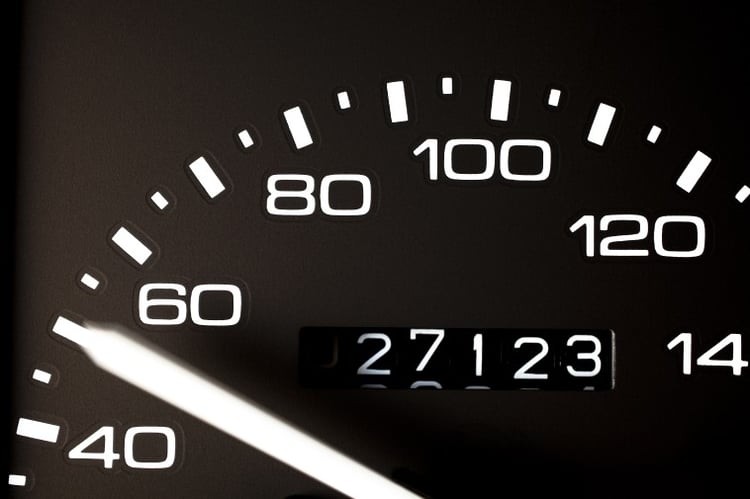
When used properly, fuel card odometer tracking can be an invaluable tool for lowering your operating costs. By entering the odometer at the gas station with every transaction, you can more easily schedule vehicle maintenance, keeping maintenance costs in check. But, more importantly, odometer tracking is essential for creating MPG reports. These essential reports allow you to easily spot inefficiencies and fraud so that you can keep costs low. But, to reap these benefits, you need to properly set up your fuel card program and explain expectations to your drivers.
How to use your fuel card odometer entry most effectively.
Make sure drivers know how to use their cards.
The first step to using your odometer entry field effectively is to draft a fuel card policy that explains exactly what is expected of drivers when they use their card. If drivers have never used these cards before, they may not be aware that they need to enter additional information after their PIN. Also, most cards with odometer tracking only record whole numbers, so drivers need to be made aware that entering any additional digits will lead to inaccurate MPGs. A simple step-by-step explanation of how your cards work can mitigate this problem and help ensure that drivers track mileage correctly every time they use their card.
It is equally important that managers follow up with drivers about any mistakes make when they enter the odometer at a gas station. This makes drivers aware of their previous errors and helps prevent future incorrect odometer entries. To prevent situations where odometer readings are repeatedly entered incorrectly, driver fuel policies should also explain consequences. This ensures that action can be taken quickly and behavior is corrected as quickly as possible.
Use the correct card setup to properly track miles driven.
Transactions need to be tied to the appropriate vehicle for mileage to be successfully recorded. This can be done with either driver or vehicle cards, but vehicle cards are usually recommended for more accurate odometer tracking.
Vehicle cards are directly tied to vehicles and allow multiple drivers access to utilize the same card. This allows odometer entry at the gas station to be linked to the appropriate vehicle regardless of which driver uses the card. This ensures that odometer entries are sequential so MPG is properly calculated.
Driver cards only work for tracking odometer entries in particular situations. Driver cards are effective when each driver only operates a single vehicle. In these cases, the driver and vehicle are interchangeable and the MPG shown for the driver will reflect that vehicle. If the driver operates multiple vehicles and the cards only prompt for PIN and odometer, then the vehicle number cannot be captured with the odometer and the MPG will not report accurately.
If your program offers more than two prompts, then driver cards can be effective in recording odometer and MPG when switching vehicles. While most programs only have two prompts, others like OTR and CFN cards allow three total inputs when purchasing fuel. In these cases, one of the additional prompts can be used for the vehicle number. This captures the odometer and vehicles entries regardless of which driver card is used and generate accurate MPG reports.
Set baseline MPG expectations for meaningful comparisons and oversight.
Using MPG reports to compare vehicles and detect irregularities is one of the most useful applications of odometer tracking. However, meaningful comparisons can only be made between vehicles of the same type or class. So, vehicle descriptions should include this information for easier comparisons.
MPG comparisons are more useful if a baseline MPG is established for each type of vehicle. The baseline MPG is the average, or expected, MPG for a type of vehicle and is used in conjunction with MPG reports to spot any irregularities in odometer entries.
To compute baseline MPGs for your vehicles, use historical MPG reports from your fuel vendor, the US Department of Energy Fuel Economy Guide or other online resources. Record this data over the course of a few months, and once you have enough data points, it's simple to calculate the average MPG for each type of vehicle. Record the average MPG for each vehicle and use it for your baseline MPG moving forward.
After you create baseline MPGs for each type of vehicle, you can then quickly compare the reported MPG for your vehicles against this figure. Significant discrepancies between a vehicle’s reported and baseline MPG can be cause for concern as they can indicate poor driver behavior, required vehicle maintenance, or fraud.
How fuel card odometer tracking can reduce vehicle costs.
MPG reports can highlight operating problems.
Odometer tracking is useful for several reasons, but is most commonly used to create MPG (miles per gallon) reports. By recording both gallons purchased and odometer entry at the time of purchase, companies can calculate the actual MPG for each vehicle between fill-ups.
MPG reports can be used to show irregularities in vehicle MPG. There are many different reasons MPG readings can be irregular or lower than expected. In many cases, this is indicative of poor driving behavior. Some examples include idling unnecessarily, not following assigned routes, speeding, or quick acceleration and braking.
Lower than normal MPG can also be a sign of required vehicle maintenance. In these cases, MPG is usually consistently lower than expected and does not vary as widely as with poor driving behavior. Vehicle problems that cause lower MPG vary widely and can be as simple as under/over-inflated tires, or as troublesome as transmission issues.
In either case, lower than normal MPG leads to an increase in your fleet’s operational costs. MPG reports help you detect these problems, allowing you to correct issues and, ultimately, lower costs.
Use odometer tracking to schedule routine maintenance.
Odometer tracking is also useful for scheduling regular vehicle maintenance. It can be used to indicate when oil changes, new tires, or other general maintenance may be needed. This helps stretch the life of your vehicles and avoid more costly maintenance down the road.
Prevent fraud by carefully monitoring odometer entries.
Fuel card programs with odometer tracking and MPG reports can also help you detect and prevent fraudulent activity.
Usually, when a fraudulent transaction occurs, the dishonest employee or thief does not have access to the company vehicle’s odometer reading. Because of this, the odometer entered will not be in line with the previous odometer entry. If the odometer entered is lower, then no MPG can be computed and you will see an error on your report. If they enter an odometer that is higher, then the MPG will be higher than expected. In either case, it should be immediately obvious something is wrong on your MPG reports.
Sometimes, dishonest employees will purchase fuel for both an unauthorized and company vehicle in a single transaction. In these cases, odometer entries will still be sequential, so MPG can be computed. However, it is still easy to spot fraudulent activity on MPG reports.
For example, if 10 gallons of a 30-gallon fuel purchase were dispensed into another vehicle, the MPG of the company vehicle will be significantly lower than usual. If the baseline MPG for the vehicle is 10 MPG, your MPG report would only show 6.67 MPG because 10 gallons were put into another vehicle.
To further protect yourself against fuel card fraud, you can also place controls on the cards so that they only work when a valid odometer is entered. Managers estimate the maximum miles each vehicle can travel between fill ups and enter these figures in their card setup. If the difference in mileage between the previous and current odometer entries is outside of this range, then the card will not activate and the driver will be unable purchase fuel. This is effective in preventing fraud in cases of stolen cards because the thief will not have knowledge of the previous odometer.
Such controls are also beneficial as they ensure only accurate odometer readings are recorded. However, they can be overly restrictive. If a driver travels further than expected on a single tank or enters an odometer entry outside of the given range, the system will prevent them from fueling. So, while odometer entries are usually more accurate with these card restrictions, the problems they cause may outweigh their benefits.
Conclusion
Fuel card odometer tracking is a powerful tool when used correctly. First, make sure your cards are set up properly so they can tie odometer entries to vehicles and so you can use this information to make meaningful comparisons through MPG reports. Once you know everything is set up properly, your drivers can begin entering odometers at gas stations. Using these entries, you can schedule maintenance, spot inefficiencies, and even detect fraud. By carefully tracking your odometer entries you can accomplish all of this and, ultimately, lower your operational costs.




